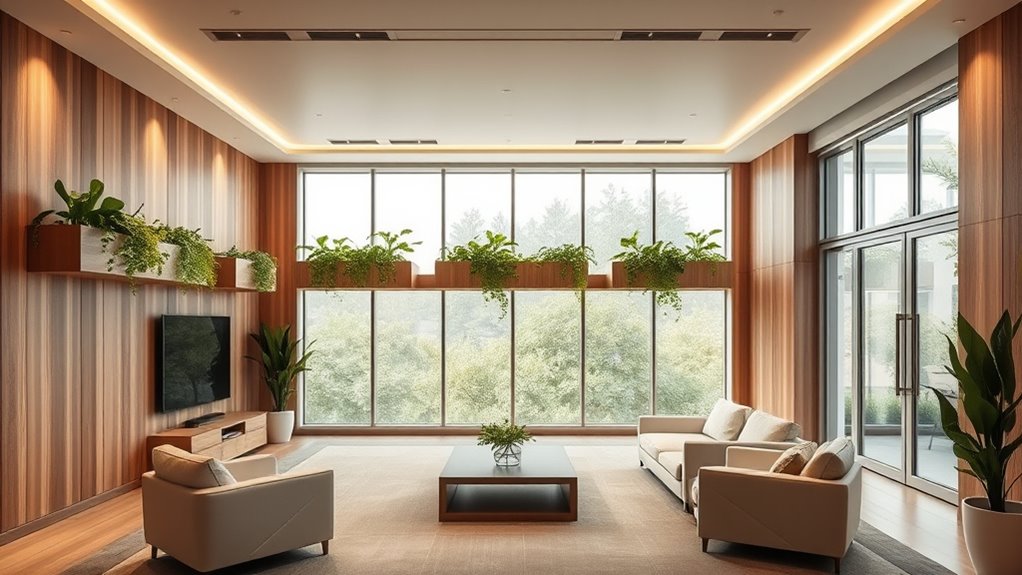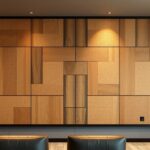To meet green building standards for media rooms, focus on using sustainable, low-toxin materials like bamboo flooring and recycled acoustic panels. Incorporate energy-efficient lighting, such as LED and ENERGY STAR-rated equipment, to reduce power use. Enhance insulation and window treatments to control temperature and cut energy costs. Use smart technology for automated lighting and ventilation with heat recovery to improve air quality and efficiency. Keep exploring to discover more ways to create a truly eco-friendly space.
Key Takeaways
- Use sustainably sourced, low-toxin materials like bamboo flooring and recycled acoustic panels to meet green building standards.
- Install energy-efficient LED lighting and ENERGY STAR-rated equipment to reduce energy consumption in media rooms.
- Incorporate proper insulation and reflective window treatments to minimize heating and cooling energy needs.
- Design with sustainable furniture and optimize ventilation systems for improved air quality and energy efficiency.
- Implement smart technologies like automated lighting and thermostats to enhance operational sustainability and safety compliance.

Creating a media room that’s both high-performing and environmentally responsible requires adherence to green building standards. You want a space that delivers exceptional audio and visual quality while minimizing your carbon footprint. To achieve this, start by selecting eco-friendly materials. These materials are sourced sustainably, contain fewer toxins, and help improve indoor air quality. Think bamboo flooring, recycled acoustic panels, and low-VOC paints. Not only do these choices reduce environmental impact, but they also create a healthier environment for everyone using the space.
Choose eco-friendly materials like bamboo flooring and recycled panels for a healthier, sustainable media room.
Energy efficiency is another critical pillar. Incorporate energy-efficient lighting to cut down on electricity consumption. LED lights are a smart choice because they use considerably less energy than traditional bulbs and have a longer lifespan. Install dimmable features so you can adjust brightness based on your needs, reducing waste. Besides lighting, consider energy-efficient audio and visual equipment. Look for products with high ENERGY STAR ratings, as they consume less power and generate less heat, which can also reduce cooling costs.
In addition to lighting and equipment, pay attention to insulation and window treatments. Proper insulation keeps your media room comfortable without over-reliance on air conditioning, which saves energy. Use window coverings like cellular shades or reflective films that block heat gain during summer and retain warmth during winter. These choices contribute to a more sustainable environment and lower energy bills.
Ventilation also plays a crucial role. An energy-efficient ventilation system with heat recovery capabilities ensures fresh air circulation without wasting energy. Proper airflow prevents mold and maintains air quality, which is especially important in media rooms where electronic equipment generates heat and moisture.
When designing the space, think about sustainable layout choices. Position speakers and screens to optimize acoustics naturally, reducing the need for additional soundproofing or electronic adjustments. Use eco-friendly furniture made from sustainable wood or recycled materials to complete the environment. This not only supports green building standards but also enhances the room’s aesthetic appeal.
Finally, incorporate smart technologies that monitor and control energy use. Automated lighting systems, programmable thermostats, and energy management software allow you to minimize waste and operate your media room efficiently. Additionally, ensuring your appliances meet appliance safety standards can prevent potential electrical issues and contribute to overall energy efficiency. By consciously choosing eco-friendly materials, energy-efficient lighting, and integrated smart controls, you’re creating a sustainable, high-performance media space that aligns with green building standards. You’ll enjoy top-quality entertainment while contributing to a healthier planet.
Frequently Asked Questions
How Do Green Standards Impact Media Room Acoustics?
Green standards improve media room acoustics by emphasizing sound insulation and material absorption. You’ll find eco-friendly materials that block noise from outside and absorb sound waves inside, creating a better environment. These standards encourage using recycled or sustainable materials that enhance sound quality while reducing environmental impact. As a result, your media room becomes quieter, with clearer audio, all while supporting eco-conscious building practices.
Are There Cost Differences Between Green and Traditional Media Rooms?
You’ll find that green media rooms often have a higher initial cost due to eco-friendly materials and energy-efficient systems, but the long-term savings on utilities and maintenance can offset these expenses. The cost comparison varies based on your budget considerations and the specific green standards you choose. While green options might require a larger upfront investment, they promote sustainability and can reduce operating costs over time.
What Eco-Friendly Materials Are Best for Media Room Construction?
Did you know eco-friendly materials can reduce energy costs by up to 30%? For your media room, opt for sustainable insulation made from recycled denim or cellulose, which offers excellent soundproofing and energy efficiency. Recycled building materials like reclaimed wood or recycled metal help lower your carbon footprint while providing durability and style. Using these eco-friendly options guarantees a greener, more energy-efficient media space without sacrificing quality or performance.
How Do Green Standards Affect Media Room Lighting Design?
Green standards influence your media room lighting design by emphasizing solar integration and natural lighting. You’ll want to maximize natural light with energy-efficient windows and shading to reduce reliance on artificial lighting. Incorporate solar-powered lighting systems that minimize energy consumption. By balancing natural and solar lighting, you create a comfortable, eco-friendly space that aligns with green building principles while enhancing your media experience.
Can Existing Media Rooms Be Retrofitted to Meet Green Standards?
You can retrofit your media room to meet green standards, but it’s like renovating a vintage car—you’ll face challenges like upgrading insulation, lighting, and HVAC systems. Retrofit challenges include balancing cost and preserving room functionality. With careful planning, you can turn your space into a green-certified haven, making it eco-friendly and energy-efficient. It’s worth the effort to transform your media room into a sustainable retreat that supports green certification goals.
Conclusion
By adopting green building standards for your media room, you not only create a healthier, more energy-efficient space but also contribute to environmental sustainability. Some might think these upgrades are costly or complicated, but many eco-friendly solutions are affordable and easy to implement. With a few simple choices, you’ll enjoy reduced energy bills and a more comfortable environment without sacrificing quality. Embrace green standards today—you’ll thank yourself in the long run.















